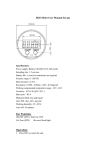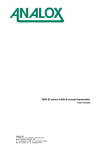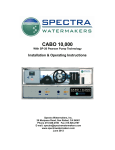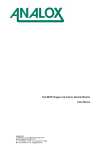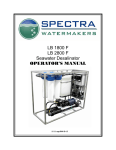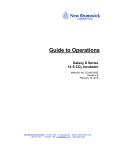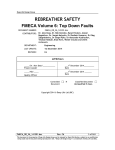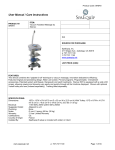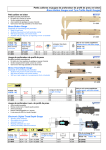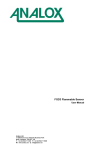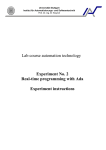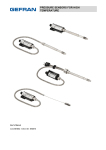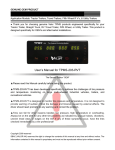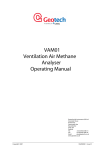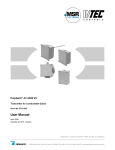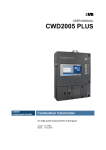Download Analox HYP O2 Portable - User Manual
Transcript
HYP O2 Portable User Manual Analox Ltd. 15 Ellerbeck Court, Stokesley Business Park North Yorkshire, TS9 5PT, UK T: +44 (0)1642 711400 F: +44 (0)1642 713900 W: www.analox.net E: [email protected] List of Contents 1 2 3 Introduction ........................................................................................................................4 Overview ............................................................................................................................5 Operation ...........................................................................................................................6 3.1 Switching on and off ......................................................................................................6 3.2 Ambient/Local atmosphere monitoring ..........................................................................6 3.3 Remote monitoring ........................................................................................................6 3.4 Low battery warning ......................................................................................................6 3.5 Note on partial pressure measurements .......................................................................7 3.6 Conversion of partial pressure measurement to a percentage measurement ..............9 3.7 Concerned whether reading is accurate?....................................................................10 3.8 Effect of temperature changes ....................................................................................10 3.9 Rapid changes of pressure..........................................................................................10 3.10 Effect of humidity.....................................................................................................11 4 Calibration ........................................................................................................................12 4.1 Frequency of check/calibration....................................................................................12 4.2 Type of calibration .......................................................................................................13 4.3 Air calibration using fresh-air without temperature or humidity compensation............14 4.4 Air calibration using fresh-air with temperature and humidity compensation ..............14 4.5 Calibration using calibration gas..................................................................................16 4.6 Calibration using pure oxygen .....................................................................................17 4.7 Calibration against a reference analyser .....................................................................18 5 Maintenance.....................................................................................................................19 5.1 Replacing battery.........................................................................................................19 5.2 Replacing oxygen sensor ............................................................................................20 6 Troubleshooting ...............................................................................................................21 6.1 Instrument will not switch on........................................................................................21 6.2 Instrument provides an oxygen reading that is believed to be incorrect .....................21 6.3 Instrument will not calibrate .........................................................................................21 7 Safety information ............................................................................................................22 8 Specifications ...................................................................................................................23 9 Spares..............................................................................................................................24 10 Disposal ...........................................................................................................................25 11 Declaration of conformity .................................................................................................26 HYP O2 Portable User Manual Document Ref: MO2-850-00 January 2013 Page 3 HYP O2 Portable User Manual 1 Introduction SAFETY WARNING Please read the information provided in Section 7 regarding the chemicals used inside the oxygen sensor. Normally, these are retained inside the sensor and pose no risk. However, if due to a fault they leak out of the sensor, the analyser must then be handled with care as detailed. The HYP O2 Portable is a versatile portable analyser, suitable for monitoring partial pressure oxygen in several applications, including: • Diving bells • Chamber atmospheres • Hyperbaric lifeboats • Submarines The compact size allows for convenient fitting within confined spaces such as diving bells and hyperbaric lifeboats, or alternatively the unit can easily be hand carried. It is very simple to use, with just a single push-button to switch power on and off, and an LCD display. A single 9V PP3 battery will power the analyser continuously for approximately 800 hours (1 month). A single recessed potentiometer permits calibration when necessary. It may be used at depths of up to 600MSW / 2000FSW, and can also be used at surface pressures. All circuit boards are specially coated to ensure protection against humidity and condensation. Readings are provided in units of bar. The HYP O2 Portable uses the latest electrochemical cell technology to ensure a fast response, stable reading and long life (up to 3 years in 20.9% oxygen at RTP). All sensors are individually temperature compensated to optimise performance across the full operating temperature range. The analyser may be used on its own for monitoring the local atmosphere directly, or alternatively it may be used with a sampling kit available as an accessory. This allows samples to be drawn from remote areas for measurement. Document Ref: MO2-850-00 January 2013 Page 4 HYP O2 Portable User Manual 2 Overview Display On/Off Switch Breather (Do not block) 9212-5H oxygen sensor Calibration Pot Document Ref: MO2-850-00 January 2013 Page 5 HYP O2 Portable User Manual 3 3.1 Operation Switching on and off Simply switch the analyser on or off by switching the on/off switch. The oxygen measurement will appear on the LCD screen within one or two seconds. The oxygen reading will be in the units specific to the analyser. assumes that bar are the units of display. 3.2 This manual Ambient/Local atmosphere monitoring When monitoring the local atmosphere around the analyser, gas will diffuse into the oxygen sensor from the atmosphere, and the display will indicate the partial pressure of oxygen to which it has been exposed. Avoid breathing out over the sensor, since exhaled breath contains a significant proportion of carbon dioxide and a corresponding deficiency of oxygen which will affect the accuracy of the reading. Conversely, some customers use the effect of breathing on the sensor as a confidence check prior to taking a reading, just to make sure that the analyser is functioning. However, they must then wait (usually say around 30 seconds) until normal mixing of the atmosphere allows the reading to settle back to a true reading. 3.3 Remote monitoring To monitor a remote atmosphere, the analyser may be used in conjunction with the remote sampling kit. Note it is assumed that the remote area is at the same pressure as the location in which the analyser is being used. The sampling kit consists of an aspirator bulb which allows the user to hand-pump a sample of gas from the remote area through a sample line and a flow adaptor which is pushed into the oxygen sensor inlet port. The aspirator must be pumped enough times to flush the sample through the sample line. As supplied, the sample line is 2m long, but this can be extended. 3.4 Low battery warning When the analyser is in use and the battery is almost exhausted (terminal voltage less than approximately 5.5V) a battery symbol will appear in the top left corner of the display. In this condition, the analyser will continue to measure oxygen for a few hours, but it is advisable to replace the battery as soon as possible. As the battery depletes further, the oxygen reading will ultimately be affected. Replace the battery as detailed in Section 5.1. Document Ref: MO2-850-00 January 2013 Page 6 HYP O2 Portable User Manual 3.5 Note on partial pressure measurements The analyser measures the partial pressure of oxygen. This is not to be confused with the percentage of oxygen in the atmosphere. In an environment where it is the partial pressure of oxygen that is physically being maintained (for example a diving bell), then the readout from the analyser is simple to understand. So for example, in a diving bell being maintained at 400mbar ppO2 the analyser will simply read 0.4bar ppO2. This will be the same whatever the depth of the diving bell, provided that the ppO2 is maintained correctly. In a submarine being maintained at a nominal air concentration of 20.9% O2, the reading on the analyser will vary according to the actual pressure inside the submarine. At 1bar absolute pressure, 20.9% oxygen will equate to a partial pressure of oxygen of 0.21bar Using the formula Oxygen ppO2 (bar) = Oxygen Percentage * Absolute Pressure (bar) /100 allows a table of ppO2 values at various pressures to be created, assuming that the atmosphere is maintained at 20.9% O2. Table 1 can be used when you know the atmospheric pressure in bar. Document Ref: MO2-850-00 January 2013 Page 7 HYP O2 Portable User Manual Table 1: ppO2 (bar) of 20.9% O2 at x bar Atmospheric Pressure Example: at a pressure of 1.05 Bar, 20.9% oxygen content gives a partial pressure of 0.22 bar ppO2 Document Ref: MO2-850-00 January 2013 Page 8 HYP O2 Portable User Manual 3.6 Conversion of partial pressure measurement to a percentage measurement To calculate the percentage concentration of oxygen from the reading of partial pressure, the user will need to know the actual pressure in the location at which the measurement has been taken. So if the reading on the analyser is R bar ppO2 and the actual pressure is known to be P bar (absolute), then the %O2 = 100 x R / P Table 2 may be used to do this calculation. Note the blank part of the table which shows that the ppO2 cannot exceed the actual pressure. Table 2: Calculate %O2 from ppO2 and Pressure in bar Example: When measuring 0.30 bar ppO2 at a pressure of 1.40 bara, the oxygen comprises 21.4% of the atmosphere being measured. Document Ref: MO2-850-00 January 2013 Page 9 HYP O2 Portable User Manual 3.7 Concerned whether reading is accurate? If you are in any doubt as to the accuracy of the analyser reading, refer to Section 6.2 for guidance on how to check the credibility of the reading. If the reading is believed to be incorrect, then the analyser should be recalibrated as detailed in Section 4. 3.8 Effect of temperature changes The oxygen sensor within the analyser is fitted with temperature compensation components which automatically adjust the output of the sensor at different temperatures. The user therefore ought not to be concerned as long as the temperature is within the normal operating temperature range. However, the compensation is not perfect, and thus it is necessary to allow for an error in measurement when working at different temperatures. We can’t specify this precisely, but we can state the typical effect on the reading with changes in temperature (see Section 8). Please note that this figure represents temperature changes which have been allowed to stabilise. Performance will be slightly poorer during temperature transitions. The user should note whether the analyser is subjected to temperature changes, and therefore assess whether there is a need to allow a settling time before taking a reading. This can be particularly important when the analyser is cold and it is taken into a warm environment to take a measurement, or the reverse situation, when the analyser is already warm and it is taken into a cold environment. 3.9 Rapid changes of pressure The analyser will withstand a wide range of operating pressure, but it must not be exposed to rapid changes of pressure. It will withstand rates of change which are accepted for humans (see Section 8). Do not pass the analyser through chamber medical locks in which the pressure is rapidly changed. Document Ref: MO2-850-00 January 2013 Page 10 HYP O2 Portable User Manual 3.10 Effect of humidity As stated earlier, the analyser measures the partial pressure of oxygen. The sensor will continue to operate in high levels of humidity. The gas inlet to the oxygen sensor is protected by a hydrophobic membrane, which prevents passage of liquid water into the sensor. Care must be exercised that condensed water is not allowed to settle in the gas inlet port. A layer of water will block gas diffusion into the sensor. In practice this problem is easily overcome. Simply holding or mounting the analyser in a vertical rather than horizontal position will mean that any water collecting in the sensor inlet will simply run off the sensor. So does humidity affect the reading? As an analyser measuring partial pressure of oxygen, the answer is effectively ‘no’. However in many cases, the analyser may be used to measure atmospheres that are regarded as being ‘air’. Care has to be exercised here, since in air, as the humidity increases, it displaces nitrogen and oxygen (and any other more minor constituents). Therefore, if at the time of calibration (calibration in air only), you have not accounted for humidity, then there may be a problem with the later oxygen readings. The effect is greatest for high levels of humidity at high temperatures. At low temperature or humidity, the effect is virtually insignificant. As an example, if the analyser were calibrated at 38ºC and a relative humidity of 90% as per Section 4.4, then the actual percentage of oxygen in a fresh air environment will be 19.7%. If the pressure is 1bar, then the partial pressure to which the analyser should be adjusted will be 0.20bar. Ignoring humidity, the user may have assumed that the analyser should be calibrated to 20.9% of 1bar (0.20bar). This would result in a gain error of approximately 6% of reading on all subsequent oxygen readings. Conversely, if the same calibration were performed at 20% relative humidity and 10ºC, then the oxygen content should be assumed as 20.8% rather than 20.9%. However, failure to account for the humidity in this example would result in a gain error of approximately 0.5% of reading which to all intents and purposes will usually be insignificant. Document Ref: MO2-850-00 January 2013 Page 11 HYP O2 Portable User Manual 4 4.1 Calibration Frequency of check/calibration The analyser must be calibrated in order to provide accurate oxygen measurement. The analyser is calibrated at the factory immediately prior to shipping. The oxygen sensor used inside the analyser degrades as it is consumed over its approximate 3 year life. This characteristic makes it important to periodically calibrate the sensor to compensate for the slow degradation taking place and hence maintain the analyser in a condition where it will provide adequate measurement accuracy. The typical degradation is a decline of approximately 5% of reading per year. So an analyser reading 0.21bar immediately after calibration might be expected to read 0.20bar one year later in exactly the same conditions (oxygen, temperature and pressure). This has to be quantified against the user’s requirements for how accurately the measurements are to be made. Calibrating every 6 months would reduce the typical error above from 0.01bar down to 0.005bar which for most users is expected to be good enough. In some critical applications, some users insist that the analyser is calibrated every day. In this instance the daily ‘calibration’ is essentially little more than a ‘check’ that the instrument is still working normally. Document Ref: MO2-850-00 January 2013 Page 12 HYP O2 Portable User Manual 4.2 Type of calibration The instrument will most likely be calibrated in one of two ways depending on which best suits the intended use. For users who need to make oxygen measurements over the entire range of the sensor, it is best to calibrate using pure oxygen. For users who only expect to use the lower parts of the range (for instance in a submarine kept essentially near to normal atmospheric pressure and in air equivalent atmospheres), it may be preferable (for simplicity rather than accuracy) to simply perform an air calibration. In its simplest form this requires no specialist calibration gas, and is hence favoured by some users. However it is strictly not advisable if the analyser is then expected to make accurate measurements at significantly higher concentrations of oxygen. It also introduces further uncertainty into the calibration particularly at higher temperature/humidity. Whilst everyone expects that fresh air contains 20.9% oxygen, as relative humidity levels increase, and particularly as the temperature also increases allowing the atmosphere to carry more water vapour, then the actual amount of oxygen in the atmosphere is diluted. This can be accounted for, but to be done properly does require knowledge of both temperature and relative humidity. It is also possible to use a calibration gas, say calibration air. This overcomes the humidity problem, since the calibration gas will be dry. The problem with 20.9% calibration gas, is that it’s accuracy at best is 1% of reading, and generally 2% or even 5% for some suppliers. So with a 1% accurate cal gas, a 20.9% oxygen may be anything from 20.7% up to 21.1% and a 2% accurate cal gas anything from 20.5% up to 21.3% and a 5% accurate cal gas anything from 18.9% up to 21.9% If you calibrate with say the 5% accurate gas, and leave a residual error of 1% oxygen at an air concentration, you will find that if you then subject the sensor to pure oxygen (5 times the concentration), the error will have increased to 5% oxygen. So you may believe by measurement that you are breathing 95% oxygen when in fact it is perfectly pure. By calibrating with pure oxygen, we overcome all of these problems. Firstly, pure oxygen calibration gas can be obtained to a degree of accuracy well beyond what the sensor can measure. You could use zero grade oxygen which is generally specified to be at least 99.5% pure, or you could go further and purchase oxygen with a purity of 99.995%, which in honesty is not generally worth the extra cost for this particular analyser. As with the air cal gas, the pure oxygen will be dry, so we don’t have to worry about humidity. But also, even using the 99.5% pure gas, we may have a 0.5% error in oxygen measurement, but as we now expose the sensor to air at approximately a fifth of the calibration gas concentration, the error in the air reading due to that initial 0.5% error will now be only 0.1%. This is effectively negligible in virtually all applications. So which is best? Without a doubt, calibration in pure oxygen is better as it can minimise all of the errors. But as expressed above, you can still obtain meaningful measurements using a fresh air calibration, so long as you account for temperature and humidity. Users would generally only resort to an air calibration gas in situations where it was not possible to use pure oxygen (for safety reasons) and because they do not need to measure such high levels of oxygen. Document Ref: MO2-850-00 January 2013 Page 13 HYP O2 Portable User Manual 4.3 Air calibration using fresh-air without temperature or humidity compensation In this section, it is assumed that the fresh air in the atmosphere contains 20.9% oxygen. Do not use this mode of calibration in any confined space where the level of oxygen may be slightly depleted. This is the least accurate, but simplest means of calibration. 1 2 3 4 4.4 Switch the analyser on Subject the sensor to fresh air. If the analyser was previously located at a temperature different to the fresh air, then leave the analyser for a few minutes to settle to a steady reading Calculate the expected reading. Expected reading = 0.209 x Atmospheric Pressure (bar) Use a small screwdriver to adjust the potentiometer accessible through the small hole on the front face of the analyser. Clockwise rotation will increase the reading. Adjust the reading to be as calculated above Air calibration using fresh-air with temperature and humidity compensation In this section, it is assumed that the fresh air in the atmosphere contains slightly less than 20.9% oxygen, due to dilution with water vapour. Do not use this mode of calibration in any confined space where the level of oxygen may be slightly depleted. 1 2 3 4 5 6 7 Switch the analyser on Subject the sensor to fresh air. If the analyser was previously located at a temperature different to the fresh air, then leave the analyser for a few minutes to settle to a steady reading Obtain the temperature of the environment in either Fahrenheit or Centigrade to the nearest 5°C or 10°F. Refer to Table 3 and select t he column in the table corresponding to the temperature. Obtain the relative humidity of the environment in %RH, and select the row in Table 3 corresponding to this humidity. Locate the cell in Table 3 where the selected row and column intersect. This will tell you the expected percentage of oxygen in the atmosphere. Calculate the expected ppO2 bar reading. Expected reading = Value from Table 3 x Atmospheric Pressure (bar) /100 or alternatively use Table 4 to lookup the ppO2 in bar from the %O2 and the atmospheric pressure. Use a small screwdriver to adjust the potentiometer accessible through the small hole on the front face of the analyser. Clockwise rotation will increase the reading. Adjust the reading to be as calculated above Document Ref: MO2-850-00 January 2013 Page 14 HYP O2 Portable User Manual Table 3 : Humidity Compensation Chart Atmosphere oxygen percent in relation to temperature and relative humidity Temp ºF 32 40 50 60 70 80 90 100 110 120 Temp ºC 0 4 10 16 21 27 32 38 43 49 %RH Atmospheric Oxygen Percent 0 20.9 20.9 20.9 20.9 20.9 20.9 20.9 20.9 20.9 20.9 10 20.9 20.9 20.9 20.9 20.8 20.8 20.8 20.8 20.7 20.7 20 20.9 20.9 20.8 20.8 20.8 20.8 20.7 20.6 20.5 20.4 30 20.9 20.8 20.8 20.8 20.7 20.7 20.6 20.5 20.4 20.2 40 20.8 20.8 20.8 20.7 20.7 20.6 20.5 20.4 20.2 19.9 50 20.8 20.8 20.8 20.7 20.6 20.5 20.4 20.2 20.0 19.7 60 20.8 20.8 20.7 20.7 20.6 20.5 20.3 20.1 19.8 19.5 70 20.8 20.8 20.7 20.6 20.5 20.4 20.2 19.9 19.6 19.2 80 20.8 20.8 20.7 20.6 20.5 20.3 20.1 19.8 19.5 19.0 90 20.8 20.7 20.7 20.6 20.4 20.3 20.0 19.7 19.3 18.7 100 20.8 20.7 20.6 20.5 20.4 20.2 19.9 19.5 19.1 18.5 %H2O at 100% RH 0.6 0.8 1.2 1.8 2.5 3.4 4.7 6.5 8.6 11.5 Copyright © 1996 Analox Ltd Stokesley UK. All worldwide rights reserved Table 4: ppO2 in bar for given %O2 at various atmospheric pressures Atmospheric pressure (bar) 0.94 0.96 0.98 1.00 1.02 %O2 19.0 0.18 0.18 0.19 0.19 0.19 19.1 0.18 0.18 0.19 0.19 0.19 19.2 0.18 0.18 0.19 0.19 0.20 19.3 0.18 0.19 0.19 0.19 0.20 19.4 0.18 0.19 0.19 0.19 0.20 19.5 0.18 0.19 0.19 0.20 0.20 19.6 0.18 0.19 0.19 0.20 0.20 19.7 0.19 0.19 0.19 0.20 0.20 19.8 0.19 0.19 0.19 0.20 0.20 19.9 0.19 0.19 0.20 0.20 0.20 20.0 0.19 0.19 0.20 0.20 0.20 20.1 0.19 0.19 0.20 0.20 0.21 20.2 0.19 0.19 0.20 0.20 0.21 20.3 0.19 0.19 0.20 0.20 0.21 20.4 0.19 0.20 0.20 0.20 0.21 20.5 0.19 0.20 0.20 0.21 0.21 20.6 0.19 0.20 0.20 0.21 0.21 20.7 0.19 0.20 0.20 0.21 0.21 20.8 0.20 0.20 0.20 0.21 0.21 20.9 0.20 0.20 0.20 0.21 0.21 1.04 1.06 0.20 0.20 0.20 0.20 0.20 0.20 0.20 0.20 0.21 0.21 0.21 0.21 0.21 0.21 0.21 0.21 0.21 0.22 0.22 0.22 0.20 0.20 0.20 0.20 0.21 0.21 0.21 0.21 0.21 0.21 0.21 0.21 0.21 0.22 0.22 0.22 0.22 0.22 0.22 0.22 Document Ref: MO2-850-00 January 2013 Page 15 HYP O2 Portable User Manual 4.5 Calibration using calibration gas SAFETY WARNING It is assumed that personnel using this procedure have been trained in the safe use of gas and associated equipment (gas bottles, regulators etc). Do not use high pressure gas if you have not been suitably trained. To subject the analyser to a known concentration of calibration gas, use an Analox flow adaptor pushed into the sensor’s gas inlet. Connect the flow adaptor either to a constant flow regulator (as shown in Figure 1) or to a flow meter in turn connected to a pressure regulator. In either case, the aim is to achieve a flow of between 0.2 and 1.0 litres per minute of calibration gas through the flow adaptor. The calibration gas will be certified as containing x% oxygen to an accuracy of y%. The accuracy (y%) is not required in the calibration, but it is important to recognise that this leads to an uncertainty in the resulting analyser reading. Typically y will be either 1, 2 or 5% depending on the grade of gas purchased. The procedure could apply for all values of x in the range 1 to 100, but it would be very unusual to calibrate with anything less than 20% oxygen. The larger the number, the greater the accuracy of the analyser over its entire measuring range. 1 2 3 4 Switch the analyser on. If the analyser was previously located at a temperature different to the fresh air, then leave the analyser for a few minutes to settle to a steady reading Subject the sensor to calibration gas at a flow rate of between 0.2 and 1.0 litres per minute. Allow the reading to settle which will take approximately one minute. Calculate the expected reading. Expected reading = (x / 100) x Atmospheric Pressure (bar) where x is the certified percentage content of oxygen in the calibration gas Use a small screwdriver to adjust the potentiometer accessible through the small hole on the front face of the analyser. Clockwise rotation will increase the reading. Adjust the reading to be as calculated above Figure 1 : Applying Calibration Gas using constant flow regulator Document Ref: MO2-850-00 January 2013 Page 16 HYP O2 Portable User Manual 4.6 Calibration using pure oxygen SAFETY WARNING It is assumed that personnel using this procedure have been trained in the safe use of oxygen. Do not use oxygen if you have not been suitably trained. This is essentially the same as in Section 4.5, but the value x will be between 99.5 and virtually 100% depending on the grade of oxygen purchased. Use exactly the same flow rate, but note there is an additional test after calibration that is actually a very good indication of the health of the sensor. Although this is the best method of calibration (if using the entire measuring range of the analyser), some users prefer not to use it because of the need to handle pure oxygen and the associated safety precautions necessary. 1 2 3 4 5 6 7 Switch the analyser on. If the analyser was previously located at a temperature different to the fresh air, then leave the analyser for a few minutes to settle to a steady reading Subject the sensor to calibration gas (pure oxygen) at a flow rate of between 0.2 and 1.0 litres per minute. Allow the reading to settle which will take approximately one minute. Calculate the expected reading. Expected reading = (x / 100) x Atmospheric Pressure (bar) where x is the certified percentage content of oxygen in the calibration gas – typically 99.5 or 99.9% Use a small screwdriver to adjust the potentiometer accessible through the small hole on the front face of the analyser. Clockwise rotation will increase the reading. Adjust the reading to be as calculated above Remove the flow adaptor from the sensor and allow the sensor to settle to the ambient air conditions. Calculate the expected partial pressure reading for the ambient conditions. If this is fresh air at low levels of humidity, then this will be 20.9% oxygen. The expected reading will be Expected reading = 20.9 x Atmospheric Pressure (bar) / 100 For higher levels of humidity, obtain the expected percentage of oxygen by reference to Table 3, and substitute this for the 20.9 figure in the equation above. Compare the analyser reading with the expected reading. It would be expected for the reading to be within +/-0.01bar of the expected reading, provided that the expected reading is not in error due to humidity effects or mis-calculation with the assumed atmospheric pressure. At the end of the sensor’s life, it will be found that this reading will be much higher than expected – perhaps as much as 0.02 to 0.04bar. The reason for this is that as the sensor ages, it will still measure low levels of oxygen (eg air atmospheres), but it will saturate and be unable to respond to high levels of oxygen (eg pure O2). So what has happened is that the lower than expected reading for 100% O2 has been artificially increased by use of the calibration potentiometer. This then correspondingly increases the apparent oxygen content when exposed to air. The fact that the sensor cannot respond to higher levels of oxygen means the sensor is beyond the end of its useful life. Replace it at the earliest opportunity. Document Ref: MO2-850-00 January 2013 Page 17 HYP O2 Portable User Manual 4.7 Calibration against a reference analyser In some circumstances, it is not possible to use fresh air or calibration gas, and yet there is still a need to check or calibrate the instrument. This can only be done if there is a reference available in which there is a suitably low uncertainty, such that it is deemed possible to calibrate the analyser against the reference. It must be ensured that both the HYP O2 Portable and the reference are both measuring the same gas. Do not assume that simply because both analysers are in the same room that they ought to measure the same. Locate both analysers together, or subject them to the same sample gas. If the reference is a partial pressure analyser itself, then simply adjust the HYP O2 Portable analyser to give the same reading (it may be necessary to convert from one set of units to another unless both analysers are reading in Torr). If the reference analyser measures percentage of oxygen, convert this to a partial pressure by obtaining the local ambient pressure, preferably in bar. Then adjust the HYP O2 Portable analyser to give a reading equal to (%O2/100 x Ambient Pressure in Bar). Document Ref: MO2-850-00 January 2013 Page 18 HYP O2 Portable User Manual 5 5.1 Maintenance Replacing battery The analyser uses a single 9V PP3 type battery. If using the analyser at high pressure (>1.5 bar absolute), you may consider using a battery that has been tested to operate under hyperbaric conditions. These are available from Analox (refer Section 9). In truth, very few PP3 batteries are known to have failed under pressure, but in critical applications this attention to detail can minimise the risk of failure. Simply unscrew the four screws securing the lid, then slide the battery from under its retaining clip which is mounted to the enclosure base. Unclip it from the battery connector. Fit the new replacement battery to the battery connector and locate the battery under its retaining clip, before refitting the enclosure lid back into place. Ensure that the battery wiring does not become trapped in the process. Secure in place with the previously removed screws. Discard the old battery in line with your own battery disposal procedures. Document Ref: MO2-850-00 January 2013 Page 19 HYP O2 Portable User Manual 5.2 Replacing oxygen sensor Please read the safety information in Section 7 before handling oxygen sensors. The analyser uses an Analox supplied oxygen sensor. The sensor will typically last for 3 years when exposed to normal air at normal atmospheric pressure. Regular use in either high temperature environments or in situations using partial pressures of oxygen greater than 209 mbar ppO2 (0.21bar ppO2) will cause the sensor to deteriorate more rapidly, and hence shorten its life. For instance, exposure to pure oxygen at standard atmospheric pressure would effectively consume the oxygen sensor approximately five times faster than normal. If maintained in this atmosphere continuously, the sensor would need replacing typically every 6 months. However such exposure would represent fairly severe circumstances, and is not considered likely. Most commercial diving and military customers tend to replace the sensor at 12, 18 or 24 months, depending on their mode of usage. To replace the sensor: 1 Switch the analyser off 2 Remove the four cross-head screws from the enclosure lid 3 Separate the two halves of the enclosure. 4 Remove the sensor from the enclosure lid, this should just pull out 5 Disconnect the Molex two pin connector that connects the oxygen sensor to the printed circuit board 6 Fit the new oxygen sensor to the front face of the enclosure by pushing it through the larger hole from the underside 7 Connect the sensor wiring lead to the two pin connector 8 Ensure that the wiring is neat and tidy and will not become trapped when re-assembling the enclosure 9 Refasten the enclosure using the 4 screws Document Ref: MO2-850-00 January 2013 Page 20 HYP O2 Portable User Manual 6 6.1 Troubleshooting Instrument will not switch on Check that the battery is correctly inserted and that the battery is not exhausted. Check that the battery wiring has not become damaged due to being trapped in the case. Refer to the instructions in Section 5.1 about changing the battery and ensuring the wiring is not trapped. 6.2 Instrument provides an oxygen reading that is believed to be incorrect If in doubt about the oxygen measurement, it is best, if possible, to expose the analyser to a known oxygen concentration, which will give a good indication whether the instrument is working correctly or not. In many cases, a normal fresh air atmosphere is a readily available reference, although it is still necessary to know the atmospheric pressure to work out the actual partial pressure of oxygen. If fresh air is not available (for example in a submarine), then the analyser reading should be compared with that from another measuring device (refer Section 4.7), or checked against a bottle of calibration gas (refer Section 4.5). 6.3 Instrument will not calibrate If during calibration the calibration potentiometer does not provide sufficient adjustment of the readout, check first that the calibration conditions are correct. Are you trying to adjust to the correct figure for the gas to which the sensor is exposed? Ultimately, if the sensor is not replaced at the correct service intervals, an expired sensor will give too low a reading, and it will become impossible to adjust the reading to the desired value. Correct maintenance ought to ensure that this condition is never encountered, because if the analyser is required for immediate use, it will be necessary to fit a new sensor first. Document Ref: MO2-850-00 January 2013 Page 21 HYP O2 Portable User Manual 7 Safety information The oxygen sensor is an electrochemical device and contains a caustic electrolyte. Always check to make sure that it is not leaking and do not allow it onto any part of your body or clothing. When the life of the sensor has expired or it is leaking or otherwise damaged it must be disposed of safely in accordance with local regulations. The electrolyte is potassium hydroxide solution (KOH) which is hazardous. In the event of an accident, use the following first aid procedures Body Part Skin Ingestion Eye Effect Contact could result in a chemical burn. Persons with pre-existing skin disorders may be more susceptible to the effects of the substance. Corrosive. May cause sore throat, abdominal pain, nausea, and severe burns of the mouth, throat, and stomach, and may be fatal. Persons with pre-existing eye problems may be more susceptible to the effects of the substance. First Aid Procedures Immediately flush the skin thoroughly with water for at least 15 minutes. Remove contaminated clothing and wash before reuse. Obtain medical advice if continued irritation. If swallowed DO NOT INDUCE VOMITING. Wash out mouth thoroughly with water and give plenty of water to drink. Obtain medical advice immediately Irrigate thoroughly with water for at least 15 minutes. Obtain medical advice immediately. Corrosive. May cause redness, pain, blurred vision, and eye burns. Inhalation Contact can result in the permanent loss of sight. Persons with pre-existing impaired respiratory function may be more susceptible to the effects of the substance. Inhalation is not an expected hazard unless heated to high temperatures. Mist or vapour inhalation can cause irritation to the nose, throat, and upper respiratory tract. Document Ref: MO2-850-00 January 2013 Page 22 Remove to fresh air. Rest and keep warm. Obtain medical advice if applicable. HYP O2 Portable User Manual 8 Specifications Sensor type Analox 9100- 9212-5H Sensor life Up to 3 years in air at standard atmospheric pressure. Recommend replacement at 12,18 or 24 months dependant upon type of use. Range 0 to 2bar ppO2 Accuracy ± 1% of reading plus ± 1LSD Temperature effect ± 0.2% of reading per °C Long term drift typically 5% of reading per year Battery type 9V PP3 Battery life 1 month (800 hours) continuous operation 3 months operation for 8 hours per day Operating temperature range 0 to 40 °C Operating pressure range 0.8 to 60bar absolute. (approx 600 MSW / 2000FSW) Rate of compression/decompression < 2 bar /minute Dimensions 64mm (width) x 98mm (height) x 36mm (depth) Weight 0.200kg Warranty Electronics – 1 year Sensor – 3 months Document Ref: MO2-850-00 January 2013 Page 23 HYP O2 Portable User Manual 9 Spares 9100-9212-5H 2557-1855 GENPISDK SA7 100HYP CALKIT 8000-0011GA Document Ref: MO2-850-00 January 2013 Page 24 Replacement oxygen sensor Hyperbarically tested PP3 battery Sample Draw Kit, consisting of push in flow adaptor, aspirator bulb, 2m of neoprene tubing and a stainless steel probe. Calibration kit comprising 110 litre 21% oxygen balance nitrogen 0.5 litre/minute flow regulator to fit 110 litre bottle push in flow adaptor 1 metre of tubing trimming tool Flow adaptor (note not required if you already have either of the above kits) HYP O2 Portable User Manual 10 Disposal According to WEEE regulation this electronic product can not be placed in household waste bins. Please check local regulations for information on the disposal of electronic products in your area. Document Ref: MO2-850-00 January 2013 Page 25 HYP O2 Portable User Manual 11 Declaration of conformity Document Ref: MO2-850-00 January 2013 Page 26 HYP O2 Portable User Manual Appendix A Conversion Tables Table 5: Convert Dew point in °C to Relative humid ity in % Ambient Temperature (ºC) 0 4 10 16 21 27 32 38 43 49 Dew Point (ºC) -50 1 0 0 0 0 0 0 0 0 0 -25 10 8 5 3 3 2 1 1 1 1 -22 14 10 7 5 3 2 2 1 1 1 -18 20 15 10 7 5 4 3 2 1 1 -14 30 22 15 10 7 5 4 3 2 2 -11 39 29 19 13 10 7 5 4 3 2 -8 51 38 25 17 12 9 7 5 4 3 -6 60 45 30 20 15 10 8 6 4 3 -4 72 54 36 24 18 12 9 7 5 4 -2 85 64 42 28 21 15 11 8 6 4 -1 92 69 46 31 23 16 12 8 7 5 0 100 75 50 34 25 17 13 9 7 5 1 81 54 36 26 18 14 10 8 6 3 93 62 42 30 21 16 11 9 6 4 100 66 45 33 23 17 12 9 7 5 71 48 35 24 18 13 10 7 7 82 55 40 28 21 15 12 9 9 93 63 46 32 24 17 13 10 10 100 68 49 34 26 19 14 10 12 77 56 39 29 21 16 12 14 88 64 45 34 24 18 14 16 100 73 51 38 27 21 15 18 83 58 43 31 24 18 20 94 66 49 35 27 20 21 100 70 52 38 29 21 23 79 59 42 32 24 25 89 67 48 37 27 27 100 75 54 41 30 28 79 57 44 32 30 89 64 49 36 32 100 72 55 40 34 80 62 45 36 90 69 51 38 100 77 56 81 60 41 90 66 43 100 39 45 74 82 47 90 49 100 Document Ref: MO2-850-00 January 2013 Page 27




























